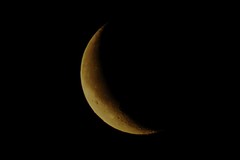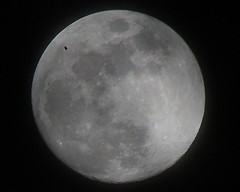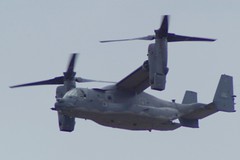Today we're looking at some macro photography I did of an atypical Phidippus audax or more commonly known as a Jumping Spider.
Found this little guy outside on my deck last night. I don't mind spiders, but my wife insist that they bite her in the middle of the night. so this guy got lucky and I was one that found him and not her.
Anyhow, this guy was only about 3/8" of inch long. I decided that this would be a good opportunity to try out my macro lens.
The settings for my camera were 260mm Macro f/5.6@1/180 ISO200. The sun was setting and I had some good lighting left.
Lesson #1-Use a tripod. It was very difficult to hand hold my camera at the correct distance to get everything in focus. Using a tripod would have made this slightly easier. The only problem would have been the lack of cooperation from the subject.
Lesson #2-Use you manual focus. I attempted to have the camera focus for me, but in macro mode it had trouble focusing. i ended up just using the manual focus.
Lesson #3-Check your f stop. I used f/5.6 to give myself some leeway with my light. This also allowed me to hand hold the camera. I needed to use a little bit higher f stop. I forgot that when you use a macro lens you have to use a slower f stop to get a good depth of field. I'm going to have to do some test and figure out what my exact distance is in macro mode with different f stops.
All in all I like working with the little guys. It's a challenge and they make some go photos when you do it correctly.
06 May 2008
01 May 2008
Moon Shots
Shooting pictures of the moon is surprisingly easy, but can still be frustrating at times.
You will need a lens with a really good focal length. For my pictures of the moon I use a 70-300 zoom at 300mm and then add a 2x tele-converter on it. The tele-converter does reduce my light by about 2 stops, but since the visible portion of the moon is lit by the sun the amount of light you are receiving is actually a lot. I set the f-stop to f/8, the ISO at 200 and zoom in as close as I can get with my lens which is approximately a 600mm focal length. This results in the moon taking up about 25-33% of my image. Depending on the amount of light the exposure times vary from 1/10th of a second up to 5 seconds. I don't recommend shooting the moon for over 2 seconds though because of the movement in both the earth and the moon. shot a couple of test shots and see what time works best.
Also you will want to set your camera to manual focus if possible. Most cameras have a hard time focusing with low light. This also the reason to have a high zoom lens so you can actually tell that you pictures are in focus.
If your camera has it, use you mirror lock up setting. This will help prevent movement of your camera when it actually snaps the picture. Another item that will help reduce camera shake is a remote shutter release.
You will also need a very sturdy tripod to work with. I recommend a tripod as opposed to other means of steadying you camera for several reasons. #1 is a tripod is easier to pan and tilt than a bean bag or other fixed object. The moon moves in a surprisingly short amount of time and it is a pain in the derriere to constantly be moving a bean bag around. #2 is a tripod leaves your hands free to do anything else you need to do and you don't have to worry about someone knocking your camera around when you turn your back. When using your tripod do not forget to take any anti-shake controls off. If you leave them on you risk having the camera think it needs to stabilize the image when it doesn't need to.
Other items that are useful to have when you are out at night are:
Flashlight (preferably a red light one)-my camera does not have the option of having a backlight to see the camera settings by and it is a pain to have to look through the eyepiece every time I want to change my shutter speed.
Appropriate clothing for the weather-you may think this means bringing a jacket during the cold months, but even during the summer the nights can get rather chilly. Gloves are also a very good idea because if your hands don't work because of the cold you won't be able to operate your camera efficiently.
Snacks & drinks-if you are planning to be out for a long period of time you will want to bring something to snack on and maybe a thermos of your favorite beverage.
Cell phone-Just in case something happens (car breaks down, bear attack, etc.). Also, whether you own a cell phone or not it is always a good idea to let someone know where you are going and what time you are planning on getting back. always expect the unexpected.
All the kit you need to keep your camera going (batteries, spare film/memory cards, etc.)-you don't have to bring your entire kit with you, but it really sucks if you're getting some great photos and your batteries run out. Before you go out make sure all of your batteries are charged.
Hopefully soon I will be able to get a decent 500mm lens that I will use with my tele-converter and get some really close pictures of the moon's surface.
You will need a lens with a really good focal length. For my pictures of the moon I use a 70-300 zoom at 300mm and then add a 2x tele-converter on it. The tele-converter does reduce my light by about 2 stops, but since the visible portion of the moon is lit by the sun the amount of light you are receiving is actually a lot. I set the f-stop to f/8, the ISO at 200 and zoom in as close as I can get with my lens which is approximately a 600mm focal length. This results in the moon taking up about 25-33% of my image. Depending on the amount of light the exposure times vary from 1/10th of a second up to 5 seconds. I don't recommend shooting the moon for over 2 seconds though because of the movement in both the earth and the moon. shot a couple of test shots and see what time works best.
Also you will want to set your camera to manual focus if possible. Most cameras have a hard time focusing with low light. This also the reason to have a high zoom lens so you can actually tell that you pictures are in focus.
If your camera has it, use you mirror lock up setting. This will help prevent movement of your camera when it actually snaps the picture. Another item that will help reduce camera shake is a remote shutter release.
You will also need a very sturdy tripod to work with. I recommend a tripod as opposed to other means of steadying you camera for several reasons. #1 is a tripod is easier to pan and tilt than a bean bag or other fixed object. The moon moves in a surprisingly short amount of time and it is a pain in the derriere to constantly be moving a bean bag around. #2 is a tripod leaves your hands free to do anything else you need to do and you don't have to worry about someone knocking your camera around when you turn your back. When using your tripod do not forget to take any anti-shake controls off. If you leave them on you risk having the camera think it needs to stabilize the image when it doesn't need to.
Other items that are useful to have when you are out at night are:
Flashlight (preferably a red light one)-my camera does not have the option of having a backlight to see the camera settings by and it is a pain to have to look through the eyepiece every time I want to change my shutter speed.
Appropriate clothing for the weather-you may think this means bringing a jacket during the cold months, but even during the summer the nights can get rather chilly. Gloves are also a very good idea because if your hands don't work because of the cold you won't be able to operate your camera efficiently.
Snacks & drinks-if you are planning to be out for a long period of time you will want to bring something to snack on and maybe a thermos of your favorite beverage.
Cell phone-Just in case something happens (car breaks down, bear attack, etc.). Also, whether you own a cell phone or not it is always a good idea to let someone know where you are going and what time you are planning on getting back. always expect the unexpected.
All the kit you need to keep your camera going (batteries, spare film/memory cards, etc.)-you don't have to bring your entire kit with you, but it really sucks if you're getting some great photos and your batteries run out. Before you go out make sure all of your batteries are charged.
Hopefully soon I will be able to get a decent 500mm lens that I will use with my tele-converter and get some really close pictures of the moon's surface.
29 April 2008
Thunder Over Louisville 2008
Here's a lesson on trusting your gut when doing a photo shoot.
I spent the day in Louisville during Thunder Over Louisville which is the opening of Derby month. There was an airshow followed by a huge fireworks display. I had Googled online to find information on how to shoot fast jets and other aircraft. The recommendations were to shoot at 1/1000th or faster at f/8. Those settings would be able to stop the jets going at speed.
One problem, the weather was not cooperating. The sky was extremely overcast. Doing a check of the light situation I found that I was not going to be able to get those speeds without boosting the ISO to 800. I really hate shooting at higher than ISO400 especially on days like that. Combine that with my poor choice of using a 2x teleconvertor, and I really had pushed myself into a bad lighting situation.
"What the hey," I thought, "I can always fix any problems in Photoshop." I should have listened to my gut that was telling me not to use the teleconvertor and just go with the 70-300mm zoom and set the ISO to 400. Instead I used the teleconvertor, boosted my ISO to 800 and shot away.
As you can see from the photos, shooting gray jets on a gray overcast sky sucks to begin with and I had to compound it with my poor choices. If I had gone with my gut I wouldn't have lost 2 stops of light.
Lesson learned.
I spent the day in Louisville during Thunder Over Louisville which is the opening of Derby month. There was an airshow followed by a huge fireworks display. I had Googled online to find information on how to shoot fast jets and other aircraft. The recommendations were to shoot at 1/1000th or faster at f/8. Those settings would be able to stop the jets going at speed.
One problem, the weather was not cooperating. The sky was extremely overcast. Doing a check of the light situation I found that I was not going to be able to get those speeds without boosting the ISO to 800. I really hate shooting at higher than ISO400 especially on days like that. Combine that with my poor choice of using a 2x teleconvertor, and I really had pushed myself into a bad lighting situation.
"What the hey," I thought, "I can always fix any problems in Photoshop." I should have listened to my gut that was telling me not to use the teleconvertor and just go with the 70-300mm zoom and set the ISO to 400. Instead I used the teleconvertor, boosted my ISO to 800 and shot away.
As you can see from the photos, shooting gray jets on a gray overcast sky sucks to begin with and I had to compound it with my poor choices. If I had gone with my gut I wouldn't have lost 2 stops of light.
Lesson learned.
Labels:
"thunder over louisville",
aircraft,
fireworks,
jets
27 April 2008
BotCon 2008
Thought I'd throw some quick photos from BotCon 2008 up for you folks. For those of you that don't know what BotCon is (and I confess I had not heard of it until this last week) it is a convention for all things concerning Transformers.
I took my son and one of his friends to it and of course they had a blast. Not that I didn't, mind you. Being the big kid in heart I couldn't help but have fond memories when I saw the old school Transformers, from Megatron (when it was OK for him to be a gun) to the Insecticons & Constructicons.
As much of a fan of Japanese anime that I am and the new live action movie, I much rather prefer the old 80's versions of the Transformers. It's just not the same now. If you ever get a chance to watch one of the 80's Transformers movies, do it, along with any of the kids you may have. Show them part of your childhood. You'll both appreciate it.
I took my son and one of his friends to it and of course they had a blast. Not that I didn't, mind you. Being the big kid in heart I couldn't help but have fond memories when I saw the old school Transformers, from Megatron (when it was OK for him to be a gun) to the Insecticons & Constructicons.
As much of a fan of Japanese anime that I am and the new live action movie, I much rather prefer the old 80's versions of the Transformers. It's just not the same now. If you ever get a chance to watch one of the 80's Transformers movies, do it, along with any of the kids you may have. Show them part of your childhood. You'll both appreciate it.
24 April 2008
Starting it out
 I figure I would start this blog with a little humor. This is also a good example of being in the right place at the right time and being ready for the shot.
I figure I would start this blog with a little humor. This is also a good example of being in the right place at the right time and being ready for the shot. I was shooting photos for a friend's party and they wanted to get the horses out and give the kids rides. This horse decided it had to take a bathroom break. The composition with the boy looking back with the look like "Did I spring a leak?" makes the photo.
This photo would have been better in a vertical format, but it was a matter of getting the shot in focus and shooting it.
Data:
Pentax K100D Super
Pentax DA 18-15mm Zoom
200 ISO 1/125 sec @ f/5.6
Conditions-Outdoors, Overcast w/ clouds
Subscribe to:
Posts (Atom)







